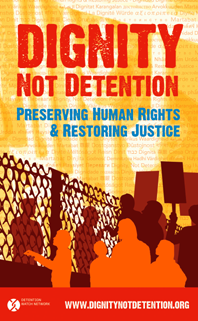March 22, 2010
by Pedro Rios
Originally published on Detention Watch Network
Detention Watch Network chose the image of San Diego’s Friendship Park to represent our “Dignity not Detention” campaign (see on left). To explain its significance, we asked Pedro Rios of American Friends Service Committee in San Diego to write about his experience with Friendship Park and recent changes that have affected it.
Containment Society: Reproducing Detention at Friendship Park
It was a somber 16th Annual Posada Sin Fronteras (Posada Without Borders) last December, held at Friendship Park. There was an impressionable eeriness about the altered landscape; a feeling of loss prevailed. La Posada, where every year a couple of hundred people gather to remember the migrant lives lost in their attempts to cross into the United States, this time, for the first time, the event took place inside the strip of land contained within the primary and secondary fencing infrastructure that now outlines significant portions of the US-Mexico border. Those 25 people permitted entry into this “security zone” were further enclosed inside a 5-foot tall pedestrian barrier set to confine the access area around Monument Mesa. Human touch was no longer permitted between people on either side of the border wall. Of this scenario, my 7 year-old son commented, “It looks like we are going into a jail.”
Adding insult to injury, as we shared migrant testimonies, sang traditional posada songs, and even when our emotions overwhelmed some of us, standing behind us armed Border Patrol agents intruded by snapping pictures, some only 6 feet away, as if to remind us of the control and of the loss – they captured this in pictures and with video as if the enclosed steel pen surrounding our group didn’t already sufficiently attempt to degrade our humanity.
We all know about the crisis in immigration detention in the United States – the systemic violations – even the government acknowledges its detention centers are plagued by substandard conditions. Those secret detention facilities and news stories about unnecessary deaths point to the disarray that has become the norm for how human beings are locked up. It is completely intolerable that this occurs as corporations profit from it, but it also has been taking place in the public domain, and elements of detention and its horrors get reproduced in how public space is defined. Friendship Park is a clear example of that.
In 1849, shortly after the signing of the Treaty of Guadalupe Hidalgo, the historic Monument Mesa became the site for demarcating the boundary between the U.S. and Mexico. This was recognized with a monument in the 1880s, at the same point where in 1971 Pat Nixon commemorated the celebrated site as Friendship Park remarking, “I hope there won’t be a fence here too long.”
For decades and until recently, bi-national events held at Friendship Park have included yoga and salsa classes, the cultivation of a bi-national garden, beach clean-ups, communions, Day of the Dead ceremonies, and the annual La Posada Sin Fronteras. Perhaps the most significant events but less profiled, were the personal family reunions that used to take place on any given day – a grandfather caressing the cheek of his 3 month old grandson for the first time, or a husband meeting his wife and children, interlocking fingers in spite of the metal mesh between their palms. Under the new “Rules for Entry” these timeless moments are forbidden.
The new “Rules for Entry” were established without proper consultation with community organizations, much less with the acknowledgement of the general public. Borrowed from military-speak, the central gauge for the Border Patrol is “operational control.” So long as the Border Patrol aspires towards this militaristic concept in gauging their threat assessment of the area, public space, in this case, Friendship Park, is subject to stringent containment and overzealous social control.
For years the challenge to fend off the border wall at Friendship Park brought together advocates from different experiences and vantage points – environmentalists, human rights advocates, grass roots organizations, and private citizens – all with the intention of preserving the dignity of Friendship Park and its unique surrounding landscape. The efforts to restore public access continue, despite the new physical infrastructure that restrains expression of true friendship and solidarity with our neighbors to the south.
At La Posada, when our friends in Tijuana threw candy bags over the primary fence, a customary symbolic act representing gift-sharing like in the breaking of a Mexican piñata, Border Patrol agents were quick to confiscate the candy, claiming it was contraband. The event ended and Border Patrol agents were quick to scurry us out of the containment area, closing the gate of the secondary fence behind us. The orange glow of the luminarias that were lit with the names of migrants who have died splashed against the metal bars that make up the secondary fence. This reminded me that in our struggle for a restoration of justice in how human beings are detained in immigration facilities, confinement gets reproduced in social spaces, Friendship Park being one of them.

